It has been argued that we are moving from the Information Age to the Interconnected Era. Businesses are becoming increasingly interdependent, and need to share data and collaborate to maintain a competitive advantage. To drive growth, it is argued, organisations must embrace digital transformation and interconnect with each other, key service providers and end users at the point of engagement.
To achieve this goal and boost revenues, enterprises are using advanced technologies and analytics to pull in more data than ever before. However, utilising these technologies presents a new set of challenges. Instead of relying solely on one set of digital services, today’s enterprises require the ability to connect in multiple combinations to the multiple partners, customers, employees and geographies needed to accelerate business performance and create new opportunities.
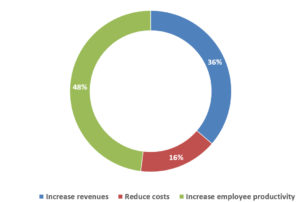
What is the core driver of your need to digitally interconnect with employees, partners, customers and others outside your core infrastructure?
Just how prepared are Irish organisations prepared for this new reality? Interconnection is crucial for organisations seeking to deal with exponential data growth, but have Irish companies taken the required steps towards capitalising on this new path towards growth and opportunity?
TechBeat, in association with Equinix, polled 103 IT professionals to find out.
The survey asked what was the core driver of the need to digitally interconnect with employees, partners, customers and others outside of core infrastructure. Almost half (48%) chose increasing employee productivity, followed by more than a third (36%) who chose increasing revenue, with reducing costs a lowly (16%) third.
“Companies are taking steps to address changing work trends (remote and flexible working, etc.) and work/life balance,” said Maurice Mortell, managing director Ireland and emerging markets, Equinix, “and availing of interconnection as a key facilitator of this.”
“Employees now expect reliable, secure and instantaneous connectivity, and the ability to utilise multiple cloud services and access real-time data across geographies. Interconnection facilitates this, while also providing access to Cloud Service Providers like AWS and Microsoft Azure that open new market opportunities for businesses,” said Mortell.
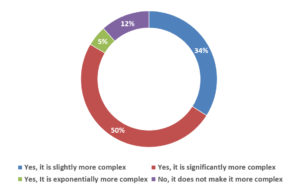
Is the explosion of external data sources, data locations and applications causing an increase in the complexity of managing the digital side of your business?
Irrespective of their state of interconnection, almost half (46%) said they expected data stored to grow by 11-20%, with 18% expecting a growth of 21-30%. Those expecting even greater growth totalled 23%. Only 2% did not expect a growth in data stored in the next 12 months.
“Data volumes are continuing to grow very strongly, and it is clear from this response that this is having a knock-on effect on the data storage needs of Irish organisations,” said Mortell. “Additionally, the impending General Data Protection Regulation (GDPR) will introduce further challenges when it comes to assessing and leveraging the value of data while remaining compliant. Adopting cloud services and outsourcing data hosting can facilitate interconnection and aid companies in achieving compliance while integrating with their broader IT strategy. Fast and private data exchange between businesses provides organisations with oversight of their data, enabling them to keep track of its location at all times”
When asked if the ever increasing number of external data sources, locations and applications were causing increased complexity in the managing the digital side of businesses, only 12% respondents said it was not. Half said it was making things significantly more complex, with 5% saying it was making things exponentially more complex.
Mortell said that this result tallies with recent research by Equinix which found that interconnection bandwidth is growing at twice the pace, and six times the volume, of public internet, as companies struggle to manage the cost and complexity of external digital relationships.
Respondents were asked for their primary concerns when using public internet to exchange data with employees, partners, customers and others outside your core infrastructure. In the multi-choice answer, more than eight out of 10 (81%) said vulnerability to theft or general security concerns, while a little more than half (52%) said lack of privacy. Slow data speeds were a concern for 30%, while closely tied on 21 and 201% respectively were cost and reliability issues.
“Due to the recent spate of cybercrime and the impending GDPR legislation,” said Mortell, “it’s not surprising to see that so many survey respondents are concerned about the vulnerability of their data to theft and privacy issues associated with use the public internet to transfer data outside their core infrastructure. However, this response really illustrates the true scale of the problem. Companies that use private connections significantly reduce the risk of their data falling into the wrong hands.”
Less than a third (29%) of organisations said that external network-related latency was causing challenges in running element of the business, due to information exchange being slow. This is encouraging in light of the fact that only 13% said they do not rely on cloud services.
Of the 87% that do rely on cloud services, a ‘select all that apply’ question found that more than half (53%) use a cloud back-up service, with 47% using software as a service, such as Salesforce. Some 44% use a cloud file storage service, and 39% use infrastructure as a service (IaaS), such as Microsoft Azure. Infrastructure as a service, such as AWS, is used by 29%, with just a point less (28%) using test and development services. Only one in 10 use a cloud based data analytics function.
In choosing a typical external enterprise data partner or cloud provider, the importance of speed of the data interconnection was gauged for the success of the relationship. More than two thirds (71%) said it was somewhat important, with almost one in five (19%) said it was the most important factor. One in 10 thought it unimportant.
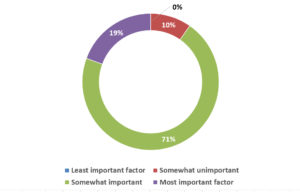
In choosing a typical external enterprise data partner/cloud provider, how important is speed of the data interconnection to the success of the relationship?
“For the 10% of companies that don’t consider speed to be important,” Mortell observed, “this could stem from the fact that these respondents are already availing of high-speed private connections, and have not had to experience the frustration of latency or delayed data transfers.”
In terms of the number of external digital business partners/data centre organisations that organisations connect with to exchange enterprise and other digital information, a third (33%) of respondents said 2-4, while more than a quarter (26%) said 1-2. A significant 17% said 5-9 providers, while 12% said 10-19. In the 20-100 range, there were 7%.
“This tallies with research carried out by Equinix,” said Mortell, “which found that as organisations embrace digital transformation and breathe new life into every aspect of their businesses, their needs become more complex and they begin to find themselves needing to interact with different business partners for different needs. This has resulted in massive growth in the amount of data being transferred between organisations.”
“The Global Interconnection Index found that as companies create new ways of connecting with customers, partners and supply chains, interconnection bandwidth is outpacing growth of the public internet.”
The primary biggest benefits (indicating the top three) of hosting enterprise data and applications in an external, carrier neutral data centre were seen as flexibility to expand (71%) and better security and reliability (60%), followed by 24 hour monitoring and minimising capital expenditure on 49% each. Ease of maintenance was close behind at 47%, but energy sustainability was a lowly 14%.

What do you see as the biggest benefits of hosting enterprise data and applications in an external, carrier neutral data centre?
“Businesses require the ability to scale according to their needs,” said Mortell, “so it’s not surprising to see that ‘flexibility to expand’ is perceived as one of the key benefits of locating data in an external, carrier neutral data centre. However, it seems that some companies underestimate the importance of faster interconnection and the inherent benefits that this provides. Faster interconnection and the benefits outlined above, external, carrier neutral data centres can provide companies with access to a huge range of markets and partners.”
Future plans are likely to rely on more efficient, reliable and scalable architectures. To that end, the survey asked whether there was a plan to digitally transform the business in the next five years. Almost two thirds (65%) said they had, with 35% saying no.
“It’s very surprising to see that 35% of survey respondents still do not have a strategy for digital transformation,” said Mortell. “The increasingly connected world in which we live has presented companies with incredible opportunities, but has also created challenges for those trying to get to grips with digital transformation. By 2050, six of the seven largest economies in the world will be from emerging nations, such as China, Indonesia and Brazil. Companies that transform their processes and offerings will prosper. Those that do not will be left behind.”
More than a third (37%) of respondents said that it was important for their organisation to connect with external digital ecosystems to scale the business, with 29% saying it was very important. Almost a quarter (23%) said it was extremely important for scaling the business. Only 14% said it was either unimportant or not at all important.
“It’s encouraging to see that companies recognise the necessity to connect with external digital ecosystems to continue to grow and expand their businesses,” said Mortell. “At the same time, it’s worrying that 14% don’t see that this type of interconnection is necessary. Organisations that do not think about the importance of their digital interconnections risk being overtaken as their competitors leverage external digital ecosystems to connect with new partners, access new markets and customers, and bring their products and services to market much faster. Given time, I expect that all companies will come to see the value of this.”
When asked to consider to be three most important facilitators of digital transformation, the ability to transfer data (68%) was top, followed by hybrid cloud infrastructure (59%), and interconnects with digital partners (57%). Analytics was at 45%, but big data was at just 21%.
“It’s great to see that we have reached the point at which Irish organisations are recognising that interconnection is a key enabler in their digital transformation journey. The majority of companies are currently striving to transform their processes to take advantage of all that the Interconnected Era has to offer. Some still view digital transformation as a mystery, but hopefully this is a sign that Irish IT managers are awakening to the fact that there are concrete steps that can be taken towards achieving it, with interconnection being the first one,” said Mortell.
Respondents were asked how important it is or would be for their business to have reliable, high-speed connections to global digital service providers such as Google, Amazon and Microsoft, that is direct interconnection on the same network.
The majority (57%) said it was very or extremely important, nearly a quarter (23%) it was important. Some 18% percent said it was unimportant and 3% regarded it as irrelevant.
“As more enterprises adopt a cloud and interconnection first strategy, the workloads will shift closer to their customers,” warned Mortell. “This will put an end to persistent end-user performance issues, security concerns, unplanned IT costs and other signs that legacy-IT architecture was struggling to keep pace with the consumer facing business. Businesses who have recognised the importance of reliable high-speed connections to the leading global digital service providers will flourish, while others who maintain that this type of interconnection is not important for their business will be left struggling to catch up.
The survey asked what percentage of the organisation’s IT budget is spent on dedicated connections to enable connection with employees, partners, customers and others outside core infrastructure. Some 30% said up to 10% of IT budget, with nearly one in five (19%) saying 11-20%. In the 21-30% of budget bracket was 11%, while the 31-40% of budget was indicated by 4%. Some individual respondents indicate brackets of 61-70% and 71-80%. Almost one in 10 said they did not spend any because they hosted in a carrier neutral data centre and 22% said they used no IT budget because they relied on public internet for interconnection.
“Utilising the public internet to connect with customers, partners and others is not sustainable in the long-term, as these companies’ data storage and transfer requirements will clearly develop over time,” Mortell warned. “As they attempt to transfer larger data packages, they will encounter latency which could impact their ability to effectively do business.”
The survey concluded by asking of the information age had given way to the interconnected era, with a very slim 51 to 49% in agreement.
“We have been heralding the dawn of the Interconnected Era for some time,” said Mortell, “and now it seems that senior IT executives feel that we have moved from the Information Age to the Interconnected Era. This is a natural evolution, as reliable and instant connectivity around the world has opened new paths to growth and opportunity.
“However, while an increasingly globalised economy has presented Irish companies with huge opportunities, it has also created a requirement for businesses to connect with their customers and partners faster than ever before. To survive and thrive in the Interconnected Era, companies need to leverage robust, enterprise-strength interconnectivity from mature providers.
“Enterprises that become ‘Interconnected Enterprises,’ by adopting an Interconnection Oriented Architecture, will be best positioned to exploit the promise of digital transformation,” he said.




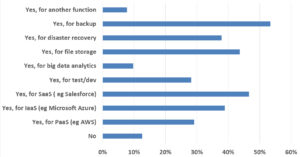

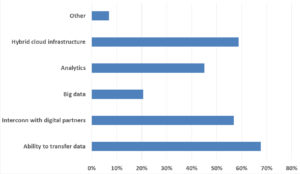
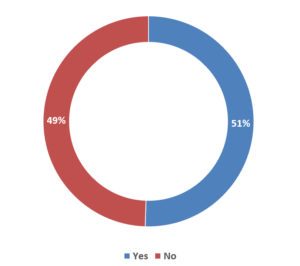




Subscribers 0
Fans 0
Followers 0
Followers